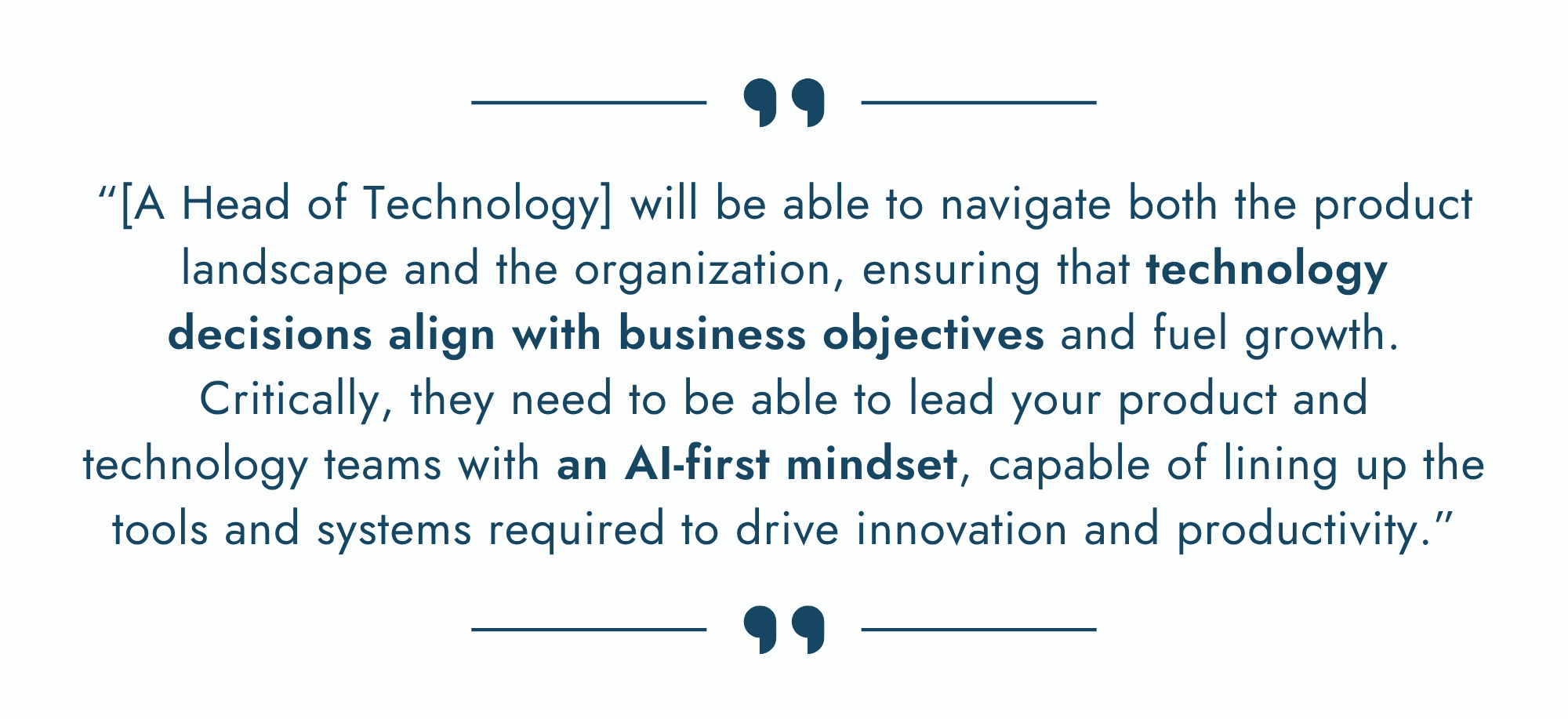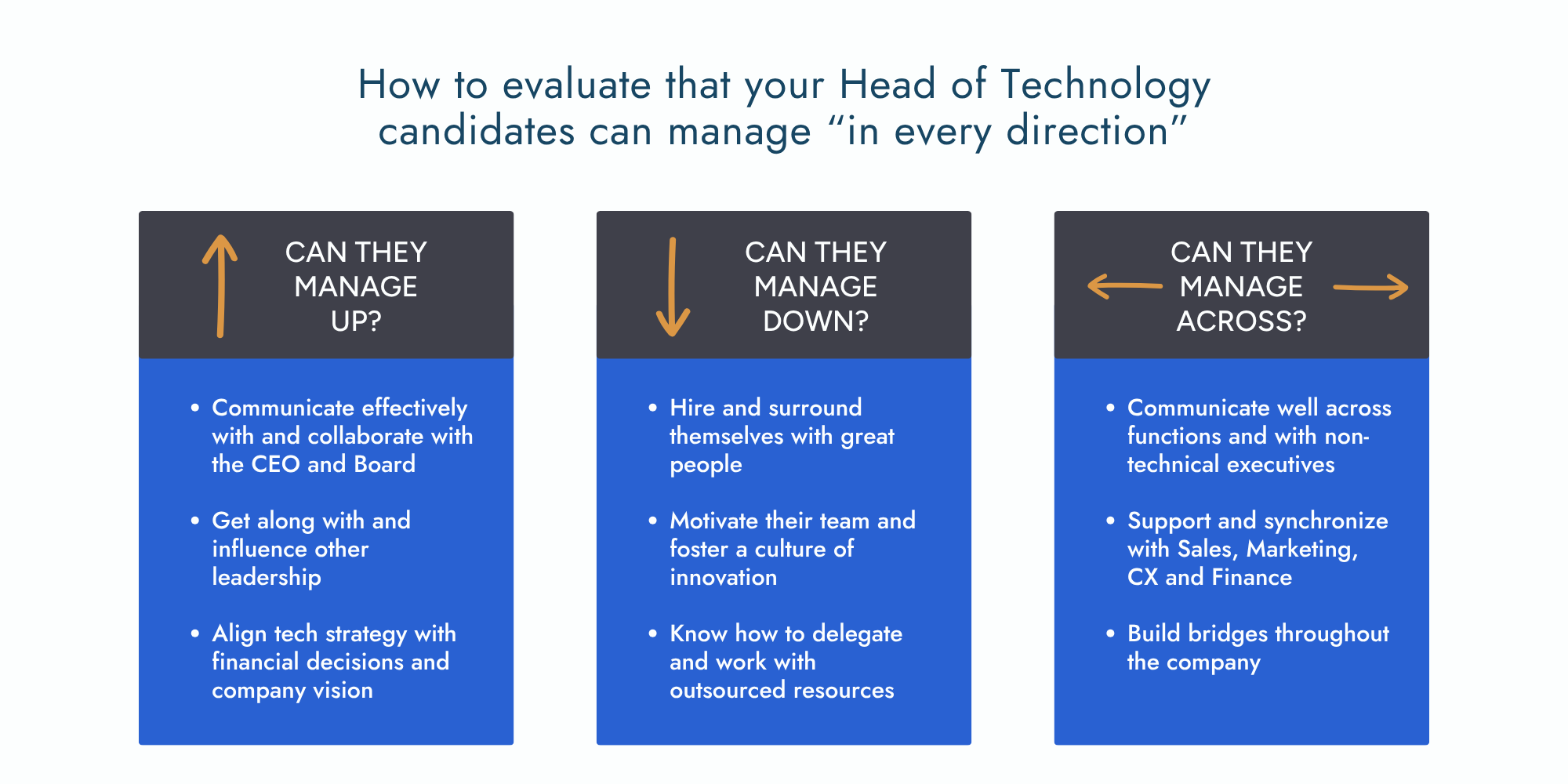This is part of Mainsail’s How-to-Hire Series: A SaaS Founder’s Guide to Building Out Your Leadership Team. Read why we put together this resource for growing SaaS businesses and how to navigate it here.
At a fast-growing SaaS company, hiring a Head of Technology is about more than just filling a leadership role—it’s securing the right person to scale operations, drive innovation and ensure long-term product success. Whether their title is CTO, VP of Engineering, Head of Technology, or CTPO, their impact extends beyond technical decisions; they bridge the gap between technology and business strategy.
To succeed in this role, your Head of Technology needs to be more than a technical expert—they must also be a strong communicator, strategic thinker and cross-functional leader. The right candidate will be able to navigate both the product landscape and the organization, ensuring that technology decisions align with business objectives to fuel growth.
Critically, they need to be able to lead your product and technology teams with an AI-first mindset, capable of lining up the tools and systems required to drive innovation and productivity.
Drawing from our experiences helping SaaS companies scale, this guide outlines when to hire a Head of Technology, what to look for in a candidate and how to set them up for success.

When to bring in a Head of Technology
Many SaaS company founders have a technical background and lead the development of the product from day one. This works in the early stage, but as a company grows it also becomes more organizationally complex. Soon, a founder will find themselves dealing with scaling infrastructure and growing teams that require new levels of management.
Then the question becomes: as the founder, can you take the product to the next level, or is it time to bring in a dedicated technology leader?
Here are some indicators it’s time to hire an outside Head of Technology:
- The team is struggling to prioritize between short-term technical fixes and long-term architectural improvements that will support future growth.
- The engineering team has grown and requires dedicated leadership.
- The technology roadmap isn’t aligning with long-term business objectives, hiring plans or scaling considerations.
Keep an eye out for priorities shifting from needing someone who can code and develop to needing someone who can offer strategic oversight, team leadership and cross-functional collaboration.
Hiring the right level of leader
In the beginning, hiring a VP of Engineering who can eventually grow into a CTO role may be the smart move. However, if your company is scaling rapidly, it’s often more effective to bring in an experienced CTO who has successfully navigated similar growth trajectories. This ensures that your technology strategy and leadership keep pace with the increasing demands of your business, helping you avoid potential roadblocks and maintain momentum.
When assessing Head of Technology candidates, look for someone who has experience in both enterprise and entrepreneurial spaces. Those with a background in enterprise environments understand structured processes, scalability and governance, while those with entrepreneurial experience bring agility, innovation and a problem-solving mindset. The best candidates often have a mix of both types of experiences and skillsets.
If possible, look for someone who has experience leading technology organizations through M&A, including assessing and integrating add-on acquisitions through a successful exit. This perspective can be useful because they have been to the “end of the road” with an exit, so they understand what to prioritize today and how to make decisions that take into consideration eventual due diligence and investor expectations.

Evaluating candidates in the interview process
A quick look at a candidate’s LinkedIn profile should be enough to tell you at a high level if they have the engineering background and technical fluency to lead the tech side of your business. But tech knowledge is not the most important characteristic in this hire. Above all, your Head of Technology needs to be a leader and a business partner.
The surest way to evaluate these traits is to ask about the candidates’ history of people management, in every direction.
Can they manage up?
Ask about times they have effectively communicated with or collaborated with the CEO and Board. Learn about their approach to aligning tech strategy with investment/financial decisions and the long-term vision for the company. Look for instances of connectivity — are they able to get along with and influence leadership?
Can they manage across?
This person will be a key bridge-builder in the company, so they need to be able to communicate across functions as well as with non-technical executives. Ask about how they previously supported and synchronized with Sales, Marketing, Customer Success and Finance.
Can they manage down?
Look for the candidate who will surround themselves with great people. In addition to hiring, developing and retaining top engineering talent, this person will be a key culture carrier for the company. Ask about their leadership and management styles, and ways they have motivated their teams and fostered a culture of innovation. Do they know how to delegate? How to work with outsourced resources?
Here are a few additional, specific attributes to assess:
- Loyalty: It’s common in tech for people to bounce around. If you see a lot of short-term jobs on their CV, address their ability to commit. You want someone who will stay with you on a 3-6-year growth journey.
- Curiosity: Are they naturally curious and willing to incorporate new tools? Are they excited about the opportunities of AI, and able to lead others to experiment and implement them effectively?
- Cultural fit: There are many ways to solve for technology, but it’s hard to fake a cultural fit. Does this person, at their core, get along with the CEO and align with their vision?
- Humility: For better or worse, Product is the first thing to get blamed when company sales are going poorly. Can this person grind without getting the glory?
- Data-driven: How do they use data to make good business decisions?
- Executive presence: Are they confident? Could you see them leading engineers on the ground floor as effectively as working with directors in the board room?
- Resilience: How have they navigated market shifts and downturns? How have they stayed steady in times of rapid growth?
Note: do not worry about which past industries they have worked in. Great tech leaders can learn a vertical; it’s much harder to learn leadership, business sense, communication and cultural fit.
Questions to ask when interviewing for a Head of Technology
- Walk me through your experience leading an engineering team during a growth phase. What challenges did you encounter, and how did you address them?
- Describe a time when you had to manage a major technology transition (re-platforming, cloud migration, etc.). What was the outcome?
- How do you ensure alignment between the technology roadmap and business objectives? Can you share an example of a time when misalignment created challenges?
- What strategies have you used to attract, hire, and retain top engineering talent?
- What technologies have you worked with? Discuss your experiences with technical stacks in both legacy and new environments. Discuss your experiences and utilization of AI.
- How do you handle misalignment with the CEO or board on technology investment or strategy?
- How have you handled technical debt, and balanced it with the need to grow?
- (Closing question to gauge cultural fit): What do you do outside of work to keep yourself sane?
The first 18 months: Setting up for success
From day one, technological fluency should be table stakes for a Head of Technology leader. It should be a given (but bears mentioning) that they have mastery over things such as: the tech stack and how to integrate it; the most efficient way to run engineering processes and workflows; the key metrics impacting the engineering team and how to track them; risk management, security and compliance.
Beyond that, success in the first 18 months should be measured by:
- Adherence to technology roadmap: Are they executing against the correct development milestones? Are they doing so with a high-quality work product and in a way that is repeatable, reliable and secure?
- Ability to forward-think, to integrate AI: Have they integrated AI into the tech roadmap in a way that strategically advances their product offering and provides tangible benefits to customers?
- Building a high-performance team: How have their recruiting, hiring, structuring and scaling efforts played out? What is the culture of the engineering team and how is that team integrating with the company?
- Impactful metrics: Is the product/technology contributing positively to key business KPIs such as customer retention, revenue growth and product adoption?
- Alignment with leadership: Has this person proven themselves to be a trusted advisor to and collaborator with the CEO and the board?
The right framework for making the hire
The right tech leader can help shape a SaaS company’s technology strategy, drive innovation and ensure it scales effectively. They can be the difference-maker in effective AI integration. As you evaluate candidates for this hire, remember it’s not just their technical abilities or their CVs — it’s about their ability to lead, strategize, scale and align the technology roadmap to a successful business outcome.
By prioritizing leadership style and cultural fit over technical skills, you can hire a technology executive who will elevate the entire organization.



